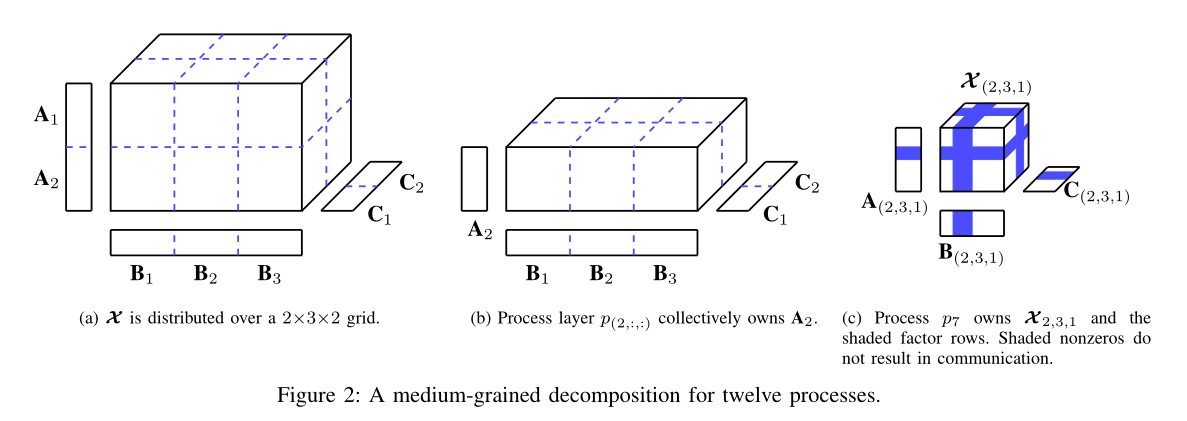
A Medium-Grained Algorithm for Distributed Sparse Tensor Factorization
ML Present a medium-grained decomposition that avoids complete factor replication and communication, while eliminating the need for expensive pre-processing steps
Abstract
Challenge:
- The computational time and memory required to compute CPD limits the size and dimensionality of the tensors that can be solved on a typical workstation, making distributed solution approaches the only viable option.
- Most methods for distributed-memory systems have focused on distributing the tensor in a coarse-grained, one-dimensional fashion that prohibitively requires the dense matrix factors to be fully replicated on each node.
- Recent work overcomes this limitation by using a fine-grained decomposition of the tensor nonzeros, at the cost of computationally expensive hypergraph partitioning.
- To that effect, we present a medium-grained decomposition that avoids complete factor replication and communication, while eliminating the need for expensive pre-processing steps.
Performance:
- #41-76x faster than a state-of-the-art MPI code, and is #1.5-5.0x faster than the fine-grained decomposition with 1024 cores.
Intro
- Contributions:
- A CPD-ALS algorithm for distributed-memory systems that uses an m-dimensional decomposition of the tensor and one-dimensional decompositions of the factors to achieve computational and memory scalability.
- A theoretical analysis of the medium-grained decomposition, which shows that it reduces the communication overhead from $O(IF)$ to $O(IF/ \sqrt[m]{p})$, where IF is the size of the output and p is the number of cores.


- The cost of Equation (2) is $4F \cdot nnz(X) \text{FLOPs}$, which is more expensive than an entire MTTKRP operation. In Section IV-B6 we present a method of reusing MTTKRP operation results to reduce the cost to 2FI.
Related work
Independent one-dimensional (1D) decompositions are used for each tensor mode. Processes own a set of contiguous slices for each mode and are responsible for the corresponding factor rows.

- Memory consumption is not scalable and since updated factors must be communicated, communication is also not scalable.
HYPERTENSOR
- The experiments presented in [9] show that a balanced partitioning of the hypergraph leads to a load-balanced computation with low communication volume.
The CSF data structure allows SPLATT to perform operation-efficient, multithreaded MTTKRP operations using a single tensor representation
MEDIUM-GRAINED CPD-ALS
- In order to address the high memory and communication requirements of the coarse-grained decomposition while at the same time eliminate the need to perform the expensive pre-processing step associated with hypergraph partitioning, we developed an approach that uses a medium-grained decomposition.
A. Data Distribution Scheme

B. Distributed CPD-ALS
- Distributed MTTKRP Operations:
- Cholesky Factorization
- Column Normalization
- Forming the New Gram Matrix
- Updating Non-Local Rows
- Residual Computation
C. Extensions to Higher Modes
D. Complexity Analysis
- $O(IF) \rightarrow O(IF/ \sqrt[m]{n})$
COMPUTING THE DATA DECOMPOSITION
- here are two forms of overhead that an ideal data decomposition will minimize: load imbalance and communication volume.
A. Finding a Balanced Tensor Decomposition
B. Partitioning the Factor Matrices
C. Choosing the Shape of the Decomposition

EXPERIMENTAL METHODOLOGY & RESULTS

CONCLUSIONS AND FUTURE WORK
We introduced a medium-grained decomposition for sparse tensor factorization. The decomposition addresses the limitations of coarse-grained methods by avoiding complete replication and communication of the factors. In addition, the medium-grained decomposition does not require computationally expensive pre-processing such as hypergraph partitioning to have a low communication volume.